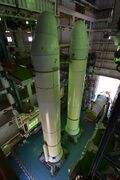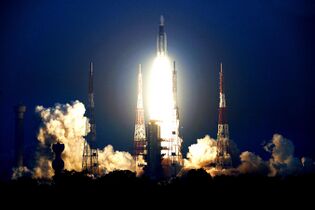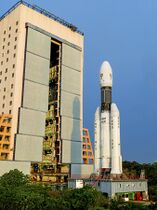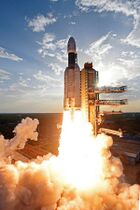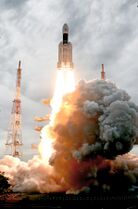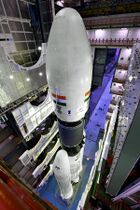Engineering:GSLV Mark III
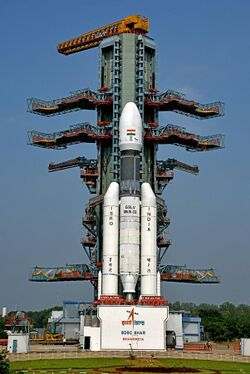 GSLV Mk III D2 on Second Launch Pad, SDSC-SHAR | |
| Function | Medium-lift launch vehicle[1] |
|---|---|
| Manufacturer | Indian Space Research Organisation |
| Country of origin | India |
| Cost per launch | ₹367 crore (US$51 million)[2][3][4][5] |
| Size | |
| Height | 43.43 m (142.5 ft)[6][1] |
| Diameter | 4 m (13 ft)[6] |
| Mass | 640,000 kg (1,410,000 lb)[1] |
| Stages | 3[1] |
| Capacity | |
| Payload to LEO | 10,000 kg (22,000 lb)[7] |
| Payload to GTO | 4,000 kg (8,800 lb)[1] |
| Associated rockets | |
| Family | Geosynchronous Satellite Launch Vehicle |
| Comparable | |
| Launch history | |
| Status | Active |
| Launch sites | Satish Dhawan Space Centre SLP, Andhra Pradesh, India |
| Total launches | 4 |
| Successes | 4 |
| Failures | 0 |
| First flight |
|
| Last flight | 22 July 2019 |
| Notable payloads | CARE, Chandrayaan-2 |
| First stage – S200 Boosters | |
| Length | 25 m (82 ft)[1] |
| Diameter | 3.2 m (10 ft)[1] |
| Empty mass | 31,000 kg (68,000 lb) each[8] |
| Gross mass | 236,000 kg (520,000 lb) each[8] |
| Propellant mass | 205,000 kg (452,000 lb) each[8] |
| Motor | Solid S200 |
| Thrust | 5,150 kN (525 tf)[9][10][11] |
| Specific impulse | 274.5 seconds (2.692 km/s) (vacuum)[8] |
| Burn time | 128 s[8] |
| Fuel | HTPB[8] |
| Second stage – L110 | |
| Length | 21.39 m (70.2 ft)[12] |
| Diameter | 4.0 m (13.1 ft)[8] |
| Empty mass | 9,000 kg (20,000 lb)[12] |
| Gross mass | 125,000 kg (276,000 lb)[12] |
| Propellant mass | 116,000 kg (256,000 lb)[12] |
| Engines | 2 Vikas engines |
| Thrust | 1,598 kN (163.0 tf)[8][13][14] |
| Specific impulse | 293 seconds (2.87 km/s)[8] |
| Burn time | 203 s[12] |
| Fuel | UDMH / N 2O 4 |
| Third stage – C25 | |
| Length | 13.545 m (44.44 ft)[8] |
| Diameter | 4.0 m (13.1 ft)[8] |
| Empty mass | 5,000 kg (11,000 lb)[12] |
| Gross mass | 33,000 kg (73,000 lb)[12] |
| Propellant mass | 28,000 kg (62,000 lb)[8] |
| Engines | 1 CE-20 |
| Thrust | 196.5 kN (20.04 tf)[8] |
| Specific impulse | 434 seconds (4.26 km/s) |
| Burn time | 643 s[8] |
| Fuel | LOX / LH2 |
The Geosynchronous Satellite Launch Vehicle Mark III (GSLV Mk III),[1][15] also referred to as the Launch Vehicle Mark 3 (LVM3),[15] is a three-stage[1] medium-lift launch vehicle developed by the Indian Space Research Organisation (ISRO). Primarily designed to launch communication satellites into geostationary orbit,[16] it is also identified as the launch vehicle for crewed missions under the Indian Human Spaceflight Programme and dedicated science missions like Chandrayaan-2.[17][18] The GSLV Mk III has a higher payload capacity than the similarly named GSLV Mk II.[19][20][21][22]
After several delays and a sub-orbital test flight on 18 December 2014, ISRO successfully conducted the first orbital test launch of GSLV Mk III on 5 June 2017 from the Satish Dhawan Space Centre, Andhra Pradesh.[23]
In June 2018, the Union Cabinet approved ₹43.38 billion (US$610 million) to build 10 GSLV Mk III rockets over a five-year period.[24]
The GSLV Mk III launched CARE, India's space capsule recovery experiment module, Chandrayaan-2, India's second lunar mission, and will be used to carry Gaganyaan, the first crewed mission under Indian Human Spaceflight Programme. In October 2021, UK-based global communication satellite provider OneWeb entered into an agreement with ISRO to launch OneWeb satellites aboard the GSLV Mk III along with the PSLV.[25][26]
History
Development
ISRO initially planned two launcher families, the Polar Satellite Launch Vehicle for low Earth orbit and polar launches and the larger Geosynchronous Satellite Launch Vehicle for payloads to geostationary transfer orbit (GTO). The vehicle was reconceptualized as a more powerful launcher as the ISRO mandate changed. This increase in size allowed the launch of heavier communication and multipurpose satellites, future interplanetary exploration and will be human rated to launch crewed missions.[27] Development of the GSLV Mk III began in the early 2000s, with the first launch planned for 2009–2010.[28] The unsuccessful launch of GSLV D3, due to a failure in the cryogenic upper stage,[28] delayed the GSLV Mk III development program.[29][30] The GSLV Mk III, while sharing a name with the GSLV, features different systems and components.
S200 static fire tests
The first static fire test of the S-200 solid rocket booster, ST-01, was conducted on 24 January 2010. The booster fired for 130 seconds and had nominal performance. It generated a peak thrust of about 4,900 kN (1,100,000 lbf).[31][10] A second static fire test, ST-02, was conducted on 4 September 2011. The booster fired for 140 seconds and had nominal performance.[32] A third test, ST-03, was conducted on 14 June 2015 to validate the changes from the sub-orbital test flight data.[33][34]
Human rated variant of S200 or HS200 was developed for Gaganyaan programme. First static fire test of HS200 was conducted on 13 May 2022 at SDSC SHAR for the duration of 135 seconds with nominal performance.[35]
L110 static fire tests
ISRO conducted the first static test of the L110 core stage at its Liquid Propulsion Systems Centre (LPSC) test facility at Mahendragiri, Tamil Nadu on 5 March 2010. The test was planned to last 200 seconds, but was terminated at 150 seconds after a leakage in a control system was detected.[36] A second static fire test for the full duration was conducted on 8 September 2010.[37]
C25 stage tests
The first static fire test of the C25 cryogenic stage was conducted on 25 January 2017 at the ISRO Propulsion Complex (IPRC) facility at Mahendragiri, Tamil Nadu. The stage was tested for a duration of 50 seconds and had nominal performance.[38]
A second static fire test for the full in-flight duration of 640 seconds was completed on 17 February 2017.[39] This test demonstrated the repeatability of the engine performance along with its sub-systems, including the thrust chamber, gas generator, turbopumps and control components for the full duration. All of the engine parameters had nominal performance.[39]
Modifications after LVM3-X
After the suborbital test flight of GSLV Mk III, certain modifications were made to the vehicle to improve its performance. The propellant grain geometry of head end segment was changed to a 13-lobed star configuration from a 10-lobed slotted configuration and propellant load was reduced to 205 tonnes (452,000 lb) to improve performance during transonic phase of launch.[40] The CFRP payload fairing was modified to ogive shape, and the S200 booster nosecones were slanted to improve aerodynamic performance. The open inter-tank structure of the C25 cryogenic stage was redesigned to be enclosed for better aerodynamic performance.[40]
Vehicle design
The first stage consists of two S200 solid motors, also known as Large Solid Boosters (LSB) attached to the core stage. Each booster is 3.2 metres (10 ft) wide, 25 metres (82 ft) long, and carries 207 tonnes (456,000 lb) of hydroxyl-terminated polybutadiene (HTPB) based propellant in three segments with casings made out of M250 maraging steel. It is the largest solid-fuel booster after the Space Shuttle SRBs and Ariane 5 SRBs. The flex nozzles can be vectored up to ±8° using electro-hydraulic actuators operating in blow-down mode and are used for vehicle control during the initial ascent phase.[41][42][43] Hydraulic fluid for operating these actuators is stored in an externally mounted cylindrical tank at the base of each booster.[44] These boosters burn for 130 seconds and produce an average thrust of 3,578.2 kilonewtons (804,400 lbf) and a peak thrust of 5,150 kilonewtons (1,160,000 lbf) each.[42][9]
The second stage, designated L110, is a liquid-fueled stage that is 21 metres (69 ft) tall and 4 metres (13 ft) wide, and contains 110 metric tons (240,000 lb) of unsymmetrical dimethylhydrazine (UDMH) and nitrogen tetroxide (N
2O
4). It is powered by two Vikas 2 engines, each generating 766 kilonewtons (172,000 lbf) thrust, giving a total thrust of 1,532 kilonewtons (344,000 lbf).[13][14] The L110 is the first Indian clustered liquid-fueled engine. The Vikas engines uses regenerative cooling, providing improved weight and specific impulse compared to earlier Indian rockets.[42][45] Each Vikas engine can be individually gimbaled to control vehicle pitch, yaw and roll control. The L110 core stage ignites 114 seconds after liftoff and burns for 203 seconds.[42][14] Since the L110 stage is air-lit, its engines need shielding during flight from the exhaust of the operating S200 boosters and reverse flow of gases by a 'nozzle closure system' which gets jettisoned prior to L110 ignition.[46]
The cryogenic upper stage, designated C25, is 4 metres (13 ft) in diameter and 13.5 metres (44 ft) long, and contains 28 metric tons (62,000 lb) of propellant LOX and LH2, pressurized by helium stored in submerged bottles.[45][47] It is powered by a single CE-20 engine, producing 200 kN (45,000 lbf) of thrust. CE-20 is the first cryogenic engine developed by India which uses a gas generator, as compared to the staged combustion engines used in GSLV.[48]
The CFRP composite payload fairing has a diameter of 5 metres (16 ft) and a payload volume of 110 cubic metres (3,900 cu ft).[8]
Variants and upgrades
Mating with semi-cryogenic stage
The L110 core stage in the GSLV Mk III is planned to be replaced by a kerolox stage powered by the SCE-200 engine[49] to increase its payload capacity to 7.5 metric tons (17,000 lb) to geostationary transfer orbit (GTO).[50] The SCE-200 uses kerosene instead of unsymmetrical dimethylhydrazine (UDMH) as fuel and can exert a thrust of around 200 tonnes. Four such engines can be clustered in a rocket without strap on boosters to deliver up to 10 tonnes (22,000 lb) to GTO.[51]
The hydrolox upper stage C25 with nearly 25 t (55,000 lb) propellant load will be converted into C32 with higher propellant load of 32 t (71,000 lb). Total mass of avionics will be brought down by the use of miniature versions.[52] On 30 November 2020, Hindustan Aeronautics Limited (HAL) delivered an aluminium alloy based cryogenic tank, namely C32-LH2 to ISRO. The tank has capacity to accommodate 5,755 kg (12,688 lb) of fuel in a volume of 89 m3 (3,100 cu ft), designed to increase payload capacity of GSLV Mk III.[53][54]
The SCE-200 powered version will not be used for the crewed mission of the Gaganyaan spacecraft.[55][56]
In September 2019, a report quoted S. Somanath, director of Vikram Sarabhai Space Centre (VSSC) said that the semi-cryogenic engine was ready to begin testing. The SCE-200 is reported to be based on the Ukrainian RD-810.[57]
As per a frame agreement for cooperation in the peaceful uses of outer space between India and Ukraine signed in 2005, Ukraine was expected to test components of the Indian version of the engine and will fly only after successful completion of the Gaganyaan program. So, an upgraded version of the GSLV Mk III was not expected arrive before 2022.[58]
The propellant tank for the SC120 semi-cryogenic stage was delivered in October 2021 by HAL.[59]
Human-rating
While the GSLV Mk III is being human rated for Gaganyaan project, the rocket was designed with potential human spaceflight applications in consideration. The maximum acceleration during ascent phase of flight was limited to 4 g for crew comfort and 5 meter diameter payload fairing was inducted to be able to accommodate large modules like space station segments.[60]
Furthermore, a number of changes to make safety critical subsystems reliable are planned through lower operating margins, redundancy, stringent qualification requirements, revaluation, and strengthening of components.[61]
In Avionics:
- Quad redundant NGC
- Dual chain Telemetry & Telecommand Processor (TTCP)
- Integrated Health Monitoring System (LVHM)
Vehicle stages:
- High Thrust Vikas Engines of L110 core stage to operate at chamber pressure of 58.5 bar instead of 62 bar.
- Human rated S200 strapon or HS200 will operate at chamber pressure of 56.5 ksc instead of 60 ksc. Segment joints will have three O-rings each.
- Electro mechanical actuators and digital stage controllers are employed in HS200, L110 and C25 stages.[62][63]
Notable missions
X (Suborbital flight test)
The maiden flight of the GSLV Mk III occurred on 18 December 2014. The flight lifted off from the Second Launch Pad, at 04:00 UTC.[64] The test had functional boosters, a core stage and a non-functional dummy upper stage. It carried the Crew Module Atmospheric Re-entry Experiment (CARE) that was tested on re-entry.[65]
Just over five minutes into the flight, the rocket ejected CARE module at an altitude of 126 kilometres (78 mi), which then descended, controlled by its onboard motors. During the test CARE's heat shield experienced a maximum temperature of around 1,000 °C (1,830 °F). ISRO downloaded launch telemetry during the ballistic coasting phase before the radio black-out to avoid data loss in the event of a splash-down failure. At an altitude of around 15 kilometres (9.3 mi), the module's apex cover separated and the parachutes were deployed. CARE splashed down in the Bay of Bengal near the Andaman and Nicobar Islands and was recovered successfully.[66][67][68][69]
D1 (GSAT-19)
The first orbital flight of the GSLV Mk III occurred on 5 June 2017,[70] lifting off from the Second Launch Pad at 11:58 UTC. The vehicle carried the GSAT-19 communication satellite, making it the heaviest Indian rocket and payload ever launched. The satellite was successfully placed into a geostationary transfer orbit (GTO) at 170 kilometres (110 mi). The flight also tested upgrades to the design from data acquired during the suborbital test flight (See section on redesigns).[71]
M1 (Chandrayaan-2)
The first operational flight occurred on 22 July 2019,[72][18] lifting off from the Second Launch pad at 9:13 UTC. The rocket carried Chandrayaan-2, India's second mission to the Moon, consisting of an orbiter, lander and a rover.[73] The Chandrayaan-2 stack is the heaviest spacecraft launched by ISRO.[74]
Launch history
| Flight № | Date / time (UTC) | Rocket, configuration |
Launch site | Payload | Payload mass | Orbit | User | Launch outcome |
|---|---|---|---|---|---|---|---|---|
| X | 18 December 2014 04:00[75] |
LVM3-X | Second Launch Pad | 3,775 kg (8,322 lb)[76] | Sub-orbital | ISRO | Success | |
| Sub-orbital development test flight with a non-functional cryogenic stage[77] | ||||||||
| D1 | 5 June 2017 11:58[78][79][80] |
Mk III | Second Launch Pad | 3,136 kg (6,914 lb) | GTO | INSAT | Success | |
| First orbital test launch with a functional cryogenic stage[81] | ||||||||
| D2 | 14 November 2018 11:38 |
Mk III | Second Launch Pad | 3,423 kg (7,546 lb) | GTO | INSAT | Success | |
| Second orbital test flight. L110 core used upgraded Vikas engines with higher thrust.[82][83][84] | ||||||||
| M1 | 22 July 2019 09:13 |
Mk III | Second Launch Pad | 3,850 kg (8,490 lb) | EPO | ISRO | Success | |
| First operational flight of GSLV MK-III. | ||||||||
Planned launches
| Date / time (UTC) | Rocket, Configuration |
Launch site | Payload | Orbit |
|---|---|---|---|---|
| October 15 - 31 2022[85] | Mk III | Second Launch Pad | File:OneWeb's mission patch for Launch 14.jpg OneWeb's mission patch |
LPEO |
| First commercial launch of GSLV Mk III for OneWeb.[86] Launch of 36 OneWeb micro-communication satellites to 450km polar orbit. If successful will be the heaviest payload to be launched by a GSLV Mk3 and ISRO to date. | ||||
| January 2023[87] | Mk III | Second Launch Pad | LPEO | |
| Second commercial launch of GSLV Mk III for OneWeb. | ||||
| Q1 2023[88][89] | Mk III | Second Launch Pad | TLI | |
| Mission repeat of Chandrayaan-2 with a lunar lander and rover. | ||||
| TBD[90][91] | Mk III | Second Launch Pad | GTO | |
| [92][93] | ||||
| end 2023/2024[94][95] | Mk III | Second Launch Pad | LEO | |
| First uncrewed orbital demonstration flight of India's crew module. | ||||
| 2024[94] | Mk III | Second Launch Pad | LEO | |
| Second uncrewed orbital demonstration flight of crew module. | ||||
| 2024[94] | Mk III | Second Launch Pad[97][98] | LEO | |
| India's first crewed mission. Launch mass is 7,800 kg (17,200 lb) with service module,[99] capsule's mass is 3,735 kg.[99][58] | ||||
| December 2024[100] | Mk III | Second Launch Pad | TBD | |
| Launch mass is 2,500 kg; Venus orbiter and atmospheric balloon. | ||||
| 2024[101] | Mk III | Second Launch Pad | TBD | |
| India's second orbiter mission to Mars.[103][58] | ||||
| TBA | Mk III | Second Launch Pad | GTO | |
| [62] | ||||
See also
- Comparison of orbital launchers families
- Comparison of orbital launch systems
- Gaganyaan – Crewed Indian spacecraft
- Geosynchronous Satellite Launch Vehicle
- List of Indian satellites
- Medium-lift launch vehicle – Capable of lifting between 2,000 and 20,000 kg (4,400 and 44,100 lb) of payload into Low Earth orbit
- Polar Satellite Launch Vehicle
- Unified Launch Vehicle – Planned medium-to-heavy-lift rocket family to expand the Indian space program and Indian human spaceflight
References
- ↑ 1.0 1.1 1.2 1.3 1.4 1.5 1.6 1.7 1.8 "GSLV Mk III" (in en). https://www.isro.gov.in/launchers/gslv-mk-iii.
- ↑ "Launch of Chandrayaan-II". https://pib.gov.in/PressReleasePage.aspx?PRID=1592495.
- ↑ "Chandrayaan-2 launch on July 15: ISRO". 25 July 2019. https://www.thehindu.com/sci-tech/science/chandrayaan-2-mission-launch-on-july-15-isro/article27859704.ece.
- ↑ "Historic Day, Says ISRO As India's 'Baahubali' Rocket Lifts Off: 10 Facts". NDTV. https://www.ndtv.com/india-news/indias-most-powerful-home-made-rocket-to-launch-today-10-facts-1708027.
- ↑ Narasimhan, T. E. (5 June 2017). "'Fat Boy' GSLV-MK III launches today: The rocket has cost India Rs 400 cr". Business Standard. http://www.business-standard.com/article/current-affairs/fat-boy-gslv-mk-iii-launches-today-the-rocket-has-cost-india-rs-400-cr-117060500106_1.html.
- ↑ 6.0 6.1 "The first developmental flight of GSLV-Mk-III" (in en). https://www.isro.gov.in/first-developmental-flight-of-gslv-mk-iii.
- ↑ "GSLV MkIII-M1 Successfully Launches Chandrayaan-2 spacecraft - ISRO". ISRO. https://www.isro.gov.in/update/22-jul-2019/gslv-mkiii-m1-successfully-launches-chandrayaan-2-spacecraft.
- ↑ 8.00 8.01 8.02 8.03 8.04 8.05 8.06 8.07 8.08 8.09 8.10 8.11 8.12 8.13 8.14 "LVM3". http://isro.gov.in/launchers/lvm3.
- ↑ 9.0 9.1 "ISRO Press Release: S200 First Static Test (S-200-ST-01)". http://www.isro.org/pressrelease/contents/2010/pdf/S200_STATIC_TEST-01.pdf.
- ↑ 10.0 10.1 "Isro successfully tests world's 3rd largest solid booster". dna. http://www.dnaindia.com/scitech/report_isro-successfully-tests-world-s-3rd-largest-solid-booster_1338945.
- ↑ "India to test world's third largest solid rocket booster". Science and Technology Section. The Hindu News Paper. 7 December 2009. http://www.thehindu.com/sci-tech/article61220.ece.
- ↑ 12.0 12.1 12.2 12.3 12.4 12.5 12.6 "GSLV Mark III-D1 / GSAT-19 Brochure". IRSO. http://isro.gov.in/gslv-mk-iii-d1-gsat-19-mission/gslv-mark-iii-d1-gsat-19-brochure.
- ↑ 13.0 13.1 "Space Launch Report: LVM3 (GSLV Mk 3)". 22 Jul 2019. http://www.spacelaunchreport.com/gslvmk3.html.
- ↑ 14.0 14.1 14.2 "L110 test to follow S200". 4 January 2010. http://indianspaceweb.blogspot.com/2010/01/l110-test-to-follow-s200.html.
- ↑ 15.0 15.1 "As it happened: ISRO successfully launches GSLV Mark-III" (in en-IN). The Hindu. 17 December 2014. ISSN 0971-751X. http://www.thehindu.com/sci-tech/science/countdown-begins-for-gslv-markiii-launch/article6701651.ece.
- ↑ "'India masters rocket science': Here's why the new ISRO launch is special". https://www.hindustantimes.com/india-news/india-masters-rocket-science-with-isro-sucessfully-launching-gsat-29-satellite/story-m72QQBzx7fxEYLyyoMRgPI.html.
- ↑ "Two international astronauts survive space scare. How well is India prepared?". https://indianexpress.com/article/explained/two-international-astronauts-survive-space-scare-how-well-is-india-prepared-5406677/.
- ↑ 18.0 18.1 "GSLV-Mk III, India's 'Baahubali' rocket for Gaganyaan, Chandrayaan II". https://www.livemint.com/Politics/tBD0gjC3A5EF0msbcT14dK/GSLVMk-III-Indias-Bahubali-rocket-for-Gaganyaan-Chandr.html.
- ↑ "Indian Space Research Organisation preparing for three more PSLV launches" (in en-IN). The Hindu. 29 April 2011. ISSN 0971-751X. http://www.thehindu.com/todays-paper/tp-national/Indian-Space-Research-Organisation-preparing-for-three-more-PSLV-launches/article14742422.ece.
- ↑ Ramachandran, R. (22 January 2014). "GSLV MkIII, the next milestone" (in en). Frontline. http://www.frontline.in/cover-story/gslv-mkiii-the-next-milestone/article5596588.ece.
- ↑ Sengupta, Rudraneil (5 June 2017). "Cryogenic rocket engine has been developed from scratch: Isro chief". LiveMint. https://www.livemint.com/Science/EYKySpXXTRGuwUBXTlzSPP/Cryogenic-rocket-engine-has-been-developed-from-scratch-Isr.html.
- ↑ "India launches 'monster' rocket" (in en-GB). BBC News. 5 June 2017. https://www.bbc.com/news/world-asia-india-40158889.
- ↑ "India's 'Bahubali' GSLV Mk III lifts less luggage than lighter rockets". The Economic Times. 16 June 2017. http://economictimes.indiatimes.com/news/science/indias-bahubali-gslv-mk-iii-lifts-less-luggage-than-lighter-rockets/articleshow/59178611.cms.
- ↑ "Government approves Rs 10,000-crore continuation programmes for PSLV, GSLV". 7 June 2018. https://economictimes.indiatimes.com/news/science/government-approves-rs-10000-crore-continuation-programmes-for-pslv-gslv/articleshow/64483323.cms.
- ↑ "OneWeb partners with Isro to launch satellites using GSLV-MKIII, PSLV". https://economictimes.indiatimes.com/tech/tech-bytes/oneweb-partners-with-isro-to-launch-satellites-using-gslv-mkiii-pslv/articleshow/86930945.cms.
- ↑ "NSIL/ISRO and OneWeb to collaborate for taking Digital Connectivity to every Corner of the World". https://oneweb.net/media-center/nsil-isro-and-oneweb-to-collaborate-for-taking-digital-connectivity-to-every-corner-of-the-world.
- ↑ ISRO Not To Fly Living Being Before Actual Manned Space Mission: Official. NDTV Indo-Asian News Service. 14 September 2018.
- ↑ 28.0 28.1 "India's GSLV Mk-3 First Flight Pushed Back to April 2014". 4 April 2013. http://www.sawfnews.com/Health/70695.aspx.
- ↑ Pulakkat, Hari. "GSLV Mark III launch: Why ISRO's biggest challenge will be at the end of this month". The Economic Times. https://economictimes.indiatimes.com/news/science/gslv-mark-iii-launch-why-isros-biggest-challenge-will-be-at-the-end-of-this-month/articleshow/58466879.cms. "Isro had gone through a difficult period a few years ago, when a launch of its GSLV Mark II failed. This failure had its impact on GSLV Mark III as well. “Because we had problems with Mark II,” says Isro chairman Kiran Kumar, “we had to rework some facilities of Mark III for Mark II. So Mark III got slightly delayed.”"
- ↑ "GSLV Mk-III to put India on top". https://www.newindianexpress.com/states/tamil-nadu/2017/feb/26/gslv-mk-iii-to-put-india-on-top-1574839.html. "The failure of GSLV-D3 in 2010, where the first indigenous Cryogenic Upper Stage (CUS) was flight-tested, impacted the C25 stage programme due to the priority assigned for the additional investigation tests and added qualification tests demanded on CUS engine systems."
- ↑ "Successful static testing of Solid Propellant Booster Rocket Stage S200 for GSLV Mk III Launch Vehicle" (in en). https://www.isro.gov.in/update/24-jan-2010/successful-static-testing-of-solid-propellant-booster-rocket-stage-s200-gslv-mk.
- ↑ "Second Static Testing of Solid Propellant Booster Rocket Stage S200 for GSLV-Mk III Successfully Conducted". http://www.vssc.gov.in/VSSC_V4/images/NewsLetter/apr2011-dec2011/article4.htm.
- ↑ "విజయవంతంగా భూస్థిర పరీక్ష" (in en). Sakshi. 15 June 2015. https://www.sakshi.com/news/andhra-pradesh/successfully-testing-a-geostationary-248632.
- ↑ Staff Reporter (15 June 2015). "Static test of S200 motor successful" (in en-IN). The Hindu. ISSN 0971-751X. http://www.thehindu.com/todays-paper/tp-national/tp-andhrapradesh/static-test-of-s200-motor-successful/article7316301.ece.
- ↑ "ISRO successfully tests large human rated solid rocket booster for the Gaganyaan programme - ISRO". 13 May 2022. https://www.isro.gov.in/update/13-may-2022/isro-successfully-tests-large-human-rated-solid-rocket-booster-gaganyaan.
- ↑ "ISRO successfully conducts static testing of new age rocket". The Hindu. http://www.thehindu.com/sci-tech/article621253.ece.
- ↑ "ISRO Press Release:Successful Static Testing of L 110 Liquid Core Stage of GSLV - Mk III". http://www.isro.org/pressrelease/scripts/pressreleasein.aspx?Sep08_2010.
- ↑ "ISRO Successfully Tests C25 Cryogenic Upper Stage of GSLV MkIII" (in en). https://www.isro.gov.in/update/26-jan-2017/isro-successfully-tests-c25-cryogenic-upper-stage-of-gslv-mkiii.
- ↑ 39.0 39.1 "ISRO Successfully Tests its Cryogenic Stage (C25) for GSLV MkIII for the Flight Duration". http://isro.gov.in/update/18-feb-2017/isro-successfully-tests-its-cryogenic-stage-c25-gslv-mkiii-flight-duration.
- ↑ 40.0 40.1 "Outcome Budget 2016-17". Department of Space, Government of India. http://isro.gov.in/sites/default/files/article-files/budget-accounts/outcomebudget2016-2017.pdf.
- ↑ "S200 solid booster development". http://iafastro.directory/iac/archive/browse/IAC-10/C4/2/8908/.
- ↑ 42.0 42.1 42.2 42.3 "GSLV Mk. III Launch Vehicle Overview". Wayback Machine. http://www.spaceflight101.net/gslv-mk-iii.html.
- ↑ N. Gopal Raj. "GSLV Mark III faces its first experimental flight". The Hindu. http://www.thehindu.com/todays-paper/tp-features/tp-sci-tech-and-agri/gslv-mark-iii-faces-its-first-experimental-flight/article6660089.ece.
- ↑ "LVM3-CARE mission brochure". https://www.isro.gov.in/sites/default/files/flipping_book/LVM-3/CARE/files/assets/common/downloads/LVM3-brochure.pdf.
- ↑ 45.0 45.1 LVM3 ISRO 23 December 2014
- ↑ "Nozzle closure system for gsLVM3 launch vehicle". ARMS 2008. https://archive.org/details/AbstractsOfTechnicalPapersARMS2008/page/n29/mode/1up.
- ↑ "Cryogenic Gas Bottle Development & Realization - Role of non-destructive evaluation". https://www.ndt.net/article/nde-india2016/papers/A206.pdf.
- ↑ "Why ISRO's New Engine and Mk III Rocket Are Reasons to Forget 1990 Cryogenic Scandal". Wayback Machine. https://thewire.in/138915/cryogenic-ce-20-isro-gslv-mk-iii/.
- ↑ Rajwi, Tiki (2 March 2015). "Semi-cryogenic Engine: ISRO Charting a Revised Plan". http://www.newindianexpress.com/cities/thiruvananthapuram/Semi-cryogenic-Engine-ISRO-Charting-a-Revised-Plan/2015/03/02/article2693939.ece.
- ↑ "ISRO developing heavy lift launch vehicles". 30 May 2015. http://www.thehindu.com/news/cities/Thiruvananthapuram/isro-developing-heavy-lift-launch-vehicles/article7262881.ece.
- ↑ "Ukraine to test components of a powerful Indian rocket engine". http://www.russianspaceweb.com/rd810.html.
- ↑ "ISRO working on reusable GSLV Mk-III launch vehicle". The Hindu (Chennai). 2021-09-17. https://www.thehindu.com/news/national/tamil-nadu/isro-working-on-reusable-gslv-mk-iii-launch-vehicle/article36507027.ece.
- ↑ "HAL delivers biggest ever cryogenic propellant tank to ISRO". The Financial Express. 2020-11-30. https://www.financialexpress.com/lifestyle/science/hal-delivers-biggest-ever-cryogenic-propellant-tank-to-isro/2140086/.
- ↑ "HAL Delivers Biggest Ever Cryogenic Propellant Tank to ISRO". https://hal-india.co.in/HAL%20Delivers%20Bi/ND__324.
- ↑ "The ISRO Tender Notice With Fascinating New Details of Gaganyaan". https://thewire.in/space/the-isro-tender-notice-with-fascinating-technical-details-of-gaganyaan.
- ↑ Singh, Surendra (28 January 2019). "GSLV Mk III: Isro eyes kerosene to boost GSLV Mk III's lifting power to 6 trillion" (in en). https://timesofindia.indiatimes.com/india/isro-eyes-kerosene-to-boost-gslv-mk-iiis-lifting-power-to-6-trillion/articleshow/67716433.cms.
- ↑ "ISRO moves on, gears up to test semi-cryogenic engine in Ukraine". The Hindu. 19 September 2019. https://www.thehindubusinessline.com/news/science/isro-moves-on-gears-up-to-test-semi-cryogenic-engine-in-ukraine/article29451601.ece.
- ↑ 58.0 58.1 58.2 "Episode 90 – An update on ISRO's activities with S Somanath and R Umamaheshwaran". AstrotalkUK. October 24, 2019. https://astrotalkuk.org/episode-90-an-update-on-isros-activities-with-s-somanath-and-r-umamaheshwaran/.
- ↑ "HAL delivers 'heaviest' Semi-Cryogenic propellant tank to ISRO". The Economic Times. 2021-10-07. https://m.economictimes.com/news/science/hal-delivers-heaviest-semi-cryogenic-propellant-tank-to-isro/articleshow/86838143.cms.
- ↑ "2.8 2.8 The Next-Generation Launcher: GSLV-Mk III by S. Ramakrishnan". From Fishing Hamlet to Red Planet: India's Space Journey. 15 December 2015. ISBN 9789351776895. "Taking into account the LEO payload capability of up to 10 tonnes feasible with this vehicle, the payload fairing diameter was fixed as 5 metres to accommodate large modules like a space station segment or manned capsule. Incidentally, considering the possibility of future human space flight missions by India, the boost phase acceleration was capped at 4g, the standard human tolerance level accepted by spacefaring agencies."
- ↑ S. Somanath (11 August 2021). PRL Ka Amrut Vyakhyaan-02, 'Reaching the sky: Indian Launch Vehicles' (video). Event occurs at 53:10–53:40. Archived from the original on 2021-12-21. Retrieved 6 October 2021 – via YouTube.
- ↑ 62.0 62.1 "Annual Report 2020-2021". ISRO. 4 March 2021. p. 37. https://www.isro.gov.in/sites/default/files/anual_report_2020-2021_english.pdf.
- ↑ "CSIR NAL Annual Report 2020-21". https://nal.res.in/sites/default/files/inline-files/Director%20Report%202020-21%20for%20web.pdf. "In addition, ATF also successfully completed the acoustic qualification of the Strap on Electro Mechanical Actuator Structure for the GSLV MKIII launcher. This would help in improving reliability and also provide advantages in payload capability in comparison with the Electro Hydraulic actuators used earlier."
- ↑ "India launches largest rocket and unmanned capsule". 8 December 2014. https://www.bbc.com/news/world-asia-india-30527602.
- ↑ "ISRO inches closer to manned mission". The Times of India. 10 January 2014. http://articles.timesofindia.indiatimes.com/2014-01-10/india/46065854_1_crew-module-space-capsule-recovery-experiment-gslv-mark. "We will be checking the crew capsule for all parameters."
- ↑ "ISRO's unmanned crew module reaches Chennai". Wayback Machine. 21 December 2014. http://www.thehindu.com/sci-tech/science/isros-unmanned-crew-module-reaches-chennai/article6713050.ece.
- ↑ As it happened: Isro's launch of India's heaviest rocket Times of India 18 December 2014
- ↑ Sangeetha Kandavel (18 December 2014). "GSLV Mark III takes to the skies in test flight". The Hindu. http://www.thehindu.com/sci-tech/science/india-successfully-test-fires-gslv-markiii-its-heaviest-rocket/article6703691.ece?homepage=true.
- ↑ "Isro to test GSLV Mk-III, crew module on December 18". The Times of India. http://timesofindia.indiatimes.com/home/science/Isro-to-test-GSLV-Mk-III-crew-module-on-December-18/articleshow/45444522.cms.
- ↑ "GSLV Mk III breaks Isro's jinx of failure in debut rocket launches". https://timesofindia.indiatimes.com/india/gslv-mk-iii-breaks-isros-jinx-of-failure-in-debut-launches/articleshow/59008331.cms.
- ↑ Clark, Stephen (5 June 2017). "India's launcher fleet gets an upgrade with successful test flight". Spaceflight Now. https://spaceflightnow.com/2017/06/05/indias-launcher-fleet-gets-an-upgrade-with-successful-test-flight/.
- ↑ "Chandrayaan 2 lifts off successfully". 22 July 2019. https://timesofindia.indiatimes.com/india/chandrayaan-2-lifts-off-successfully-gets-a-step-closer-to-moon/articleshow/70327968.cms.
- ↑ "India Launches Chandrayaan-2 Moon Mission". 22 July 2019. https://www.nytimes.com/2019/07/22/world/asia/chandrayaan-india-moon-launch.html.
- ↑ Rajwi, Tiki (4 May 2019). "Chandrayaan-2 most complex mission: ISRO chief Sivan" (in en-IN). The Hindu. ISSN 0971-751X. https://www.thehindu.com/news/national/kerala/chandrayaan-2-most-complex-mission-sivan/article27036119.ece.
- ↑ "GSLV Mk-III: ISRO successfully test flies its heaviest rocket". The Economic Times. New Delhi. 18 December 2014. http://economictimes.indiatimes.com/news/science/gslv-mk-iii-isro-successfully-test-flies-its-heaviest-rocket/articleshow/45557768.cms.
- ↑ "First Experimental Flight of India's Next Generation Launch Vehicle GSLV Mk-III Successful". 18 December 2014. http://isro.org/update/18-dec-2014/first-experimental-flight-of-indias-next-generation-launch-vehicle-gslv-mk-iii.
- ↑ "GSLV MkIII to launch Isro's next mission". Hindustan times. 1 July 2014. http://www.hindustantimes.com/india-news/gslv-mkiii-to-launch-isro-s-next-mission/article1-1235397.aspx.
- ↑ "India's GSAT-19 Reaches Geostationary Orbit after Off-Target Injection". Spaceflight101. 10 June 2017. http://spaceflight101.com/gslv-mk3-d1/indias-gsat-19-reaches-geostationary-orbit-after-off-target-injection/.
- ↑ "GLSV Mark III rocket conducts 'all-up' launch with GSAT-19 satellite". Wayback Machine. 5 June 2017. https://www.nasaspaceflight.com/2017/06/glsv-mark-iii-rocket-launch-gsat-19-satellite/.
- ↑ "Isro successfully launches its monster rocket GSLV Mk III". https://economictimes.indiatimes.com/news/politics-and-nation/isro-successfully-launches-its-monster-rocket-gslv-mk-iii/articleshow/58999528.cms.
- ↑ "GSLV Mk III-D1/GSAT-19 Mission - ISRO". http://www.isro.gov.in/launcher/gslv-mk-iii-d1-gsat-19-mission.
- ↑ "Successful Qualification of High Thrust Vikas Engine - ISRO" (in en). https://www.isro.gov.in/update/15-jul-2018/successful-qualification-of-high-thrust-vikas-engine.
- ↑ "GSLV F08-GSAT6A Brochure - ISRO" (in en). https://www.isro.gov.in/gslv-f08-gsat-6a-mission/gslv-f08-gsat6a-brochure.
- ↑ "With eye on lunar mission, ISRO to test high-thrust Vikas engine". The New Indian Express. http://www.newindianexpress.com/states/tamil-nadu/2018/mar/28/with-eye-on-lunar-mission-isro-to-test-high-thrust-vikas-engine-1793608.html.
- ↑ Rainbow, Jason (20 September 2022). "Next batch of OneWeb satellites arrive in India for launch". SpaceNews. https://spacenews.com/next-batch-of-oneweb-satellites-arrive-in-india-for-launch/.
- ↑ "OneWeb Satellites arriving in india" (in en). http://oneweb.net/resources/oneweb-and-nsil-isro-announce-satellite-arrival-ahead-historic-launch-india.
- ↑ "Gaganyaan mission can't happen this year or next year, focus fully on safety aspects: Isro chief". Times of India. 30 June 2022. https://timesofindia.indiatimes.com/india/gaganyaan-mission-cant-happen-this-year-or-next-year-focus-fully-on-safety-aspects-isro-chief/articleshow/92579979.cms.
- ↑ "UNSTARRED QUESTION NO. 556 TO BE ANSWERED ON WEDNESDAY, JULY 20, 2022". 20 July 2022. http://164.100.24.220/loksabhaquestions/annex/179/AU556.pdf.
- ↑ Park, Si-soo (3 February 2022). "India targets August launch for Chandrayaan-3 lunar lander". SpaceNews. https://spacenews.com/india-targets-august-launch-for-chandrayaan-3-lunar-lander/.
- ↑ Kumar, Chethan (12 March 2021). "Isro aims for 7 more launches from India in 2021". The Times of India. https://timesofindia.indiatimes.com/india/isro-aims-for-7-more-launches-from-india-in-2021/articleshow/81455856.cms.
- ↑ "డిసెంబర్ లోపు పీఎస్ఎల్వీ సీ49 ప్రయోగం" (in te). 2020-09-09. https://m.sakshi.com/telugu-news/andhra-pradesh/isro-launches-pslv-c49-december-shar-1313902.
- ↑ "Annual Report 2018". ISRO. https://www.isro.gov.in/sites/default/files/annualreport2018-19.pdf.
- ↑ www.ETTelecom.com. "GSAT-20 planned for mid-2020: Isro's K Sivan - ET Telecom" (in en). https://telecom.economictimes.indiatimes.com/news/gsat-20-planned-for-mid-2020-isros-k-sivan/72277968.
- ↑ 94.0 94.1 94.2 "EXCLUSIVE: No Gaganyaan unmanned flight this year" (in en). https://www.theweek.in/news/sci-tech/2022/01/25/exclusive-no-gaganyaan-unmanned-flight-this-year.html.
- ↑ "First trial for Gaganyaan to be done by end of 2023, or beginning of 2024: Jitendra Singh" (in en). https://www.aninews.in/news/national/general-news/first-trial-for-gaganyaan-to-be-done-by-end-of-2023-or-beginning-of-2024-jitendra-singh20220913225050/.
- ↑ 96.0 96.1 96.2 "Space Assigned Numbers Authority (SANA)". https://sanaregistry.org/r/spacecraft/records/1495.
- ↑ "India's human space programme gets a fillip". http://www.newindianexpress.com/nation/2018/nov/15/indias-human-space-programme-gets-a-fillip-1898396.html.
- ↑ Inside India's 2022 Space Mission: NDTV Special, https://www.ndtv.com/video/shows/ndtv-special-ndtv-24x7/inside-india-s-2022-space-mission-ndtv-special-491571, retrieved 23 July 2019
- ↑ 99.0 99.1 Indian Manned Spacecraft. Astronautix. 2014.
- ↑ Mehta, Jatan (19 November 2020). "India's Shukrayaan orbiter to study Venus for over four years, launches in 2024". SpaceNews. https://spacenews.com/indias-shukrayaan-orbiter-to-study-venus-for-over-four-years-launches-in-2024/.
- ↑ Jatiya, Satyanarayan (18 July 2019). "Rajya Sabha Unstarred Question No. 2955". https://pqars.nic.in/annex/249/Au2955.pdf.[|permanent dead link|dead link}}] Alt URL
- ↑ "India plans second Mars mission in 2018". News18. 29 October 2014. https://www.news18.com/news/india/india-plans-second-mars-mission-in-2018-723053.html.
- ↑ Madhumathi, D.S. (10 August 2016). "ISRO sets the ball rolling for Mars Mission-2". The Hindu. http://www.thehindu.com/news/national/ISRO-sets-the-ball-rolling-for-Mars-Mission-2/article14562147.ece.
External links




